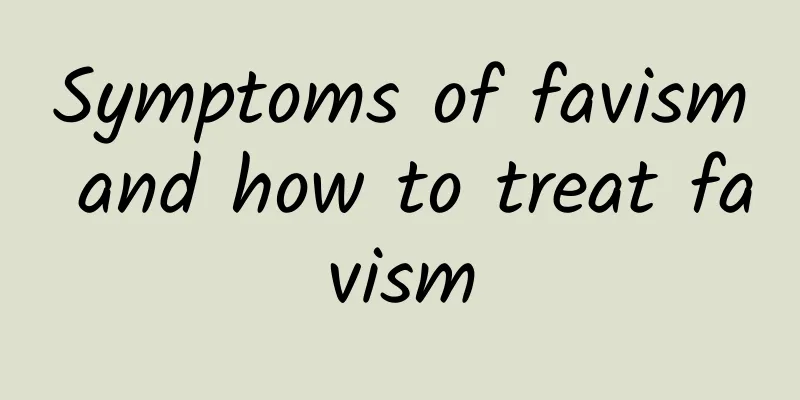Symptoms of favism and how to treat favism

|
If favism occurs, what are the symptoms of favism and how to prevent it? What are the symptoms of favism?Lin Shiguang, director of the First Department of Fuzhou Children's Hospital, said that patients usually experience acute intravascular hemolysis within 1-2 days after eating broad beans. Once the disease occurs, it is severe and manifests as general discomfort, pale face, anorexia, nausea, jaundice, dark urine (hemoglobinuria), etc. In severe cases, it may lead to coma, shock, systemic failure, and even life-threatening. Some parents usually think that the yellow skin of the children is caused by hepatitis, which leads to misdiagnosis. How to treat favism?Blood transfusion: This disease is acute hemolysis, and the anemia is severe. Blood transfusion or transfusion of concentrated red blood cells is the most effective treatment measure. In severe cases, blood transfusion can be repeated. However, the blood source should be screened for glucose-6-phosphate dehydrogenase quickly to avoid blood supply from glucose-6-phosphate dehydrogenase deficient patients, which may cause the patient to suffer from a second hemolysis. Adrenal cortex hormone: mainly has immunosuppressive effect, so it should be used early, in large amounts, and for a short period of time. Correcting acidosis: There is often varying degrees of acidosis during the hemolytic phase of favism. In severe cases, simple blood transfusion is ineffective and should be actively corrected. This is a key measure to rescue critically ill patients. Fluid replacement: Drink more water or infuse fluids to improve microcirculation, maintain effective blood circulation, and promote kidney acid excretion and hemoglobinuria excretion, but acute renal failure should be prevented. When acute renal failure occurs, attention should be paid to maintaining water and electrolyte balance. Symptomatic treatment: If favism is complicated by infection, hemolysis may be aggravated, and high fever, hypoxia and increased heart rate may lead to heart failure. Therefore, complications should be actively treated and the use of drugs that are harmful to the kidneys should be avoided. Traditional Chinese Medicine Treatment of FavismSymptoms: Bright yellow body and eyes, fever and thirst, restlessness, nausea and vomiting, abdominal distension, poor appetite, constipation, short and dark urine or soy sauce-colored urine, red tongue, yellow and greasy or yellow and rough tongue coating, and stringy or slippery pulse. Pathogenesis: After eating broad beans, the poisoning is severe. The poison enters the blood, and the blood and poison fight each other. If the poison is heavy and the blood is prosperous, there will be high fever. The toxic heat damages the liver and gallbladder, causing the liver and gallbladder to lose their ability to secrete, so that the bile does not follow the normal path and overflows on the skin to cause jaundice. Because heat is a yang evil, heat is heavier than dampness, so the body and eyes are bright yellow. If the heat evil is strong inside and burns the body fluid, there will be thirst. If the damp heat accumulates in the middle burner and the transportation and transformation are abnormal, there will be poor appetite and less food. If the stomach loses its harmony and descends, and turbid air invades, there will be nausea, vomiting, and restlessness. If the stomach and intestines are hot and the intestines are blocked, there will be fullness in the abdomen and constipation. If the damp heat descends, the evil disturbs the bladder, and the qi transformation fails, the urine will be short and red or soy sauce-colored urine. The tongue is red, the tongue coating is yellow and greasy or yellow and rough, and the pulse is stringy or slippery. This is a sign of damp heat accumulation. Treatment method: Clear away heat, detoxify, promote dampness and reduce jaundice. Prescription: The prescription is modified from Yinchen Wuling Powder. The medicinal ingredients are 15g of Yinchen, 12g of Polyporus, 10g of Poria, 10g of Alisma, 12g of Atractylodes, 15g of Scutellaria, 12g of Gardenia, 18g of Isatis, 10g of Curcuma, and 6g of Licorice. Add or subtract: For constipation, add rhubarb and immature bitter orange; for severe vomiting, add pinellia and bamboo shavings. |
<<: Causes and symptoms of favism
Recommend
The difference between yam and Jabuticaba The nutritional value of yam
Many people have seen jackfruit and jaboticaba, b...
Bitter melon crab ingredients and preparation methods
Bitter melon crab is very delicious. Here is how ...
How is NHN? NHN review and website information
What is NHN? NHN Co., Ltd. (엔에이치엔주식회사) is the larg...
The origin of longan and how to identify longan
Do you know the origin of longan and how to ident...
How to pickle fresh Jerusalem artichokes How to pickle fresh Jerusalem artichokes
Jerusalem artichoke is a food with good medicinal...
The efficacy and function of evergreen
Dieffenbachia is an ornamental plant and one of t...
What are anthocyanins? What are their effects and side effects?
Anthocyanins are basic active molecules in the bo...
The efficacy and function of baby lithospermum erythrorhizon cream. Can lithospermum erythrorhizon cream be used by babies?
Lithospermum officinale is a traditional Chinese ...
The efficacy and function of daffodils
Narcissus is a highly ornamental flower native to...
The advantages and disadvantages of eating nectarines
Nectarine is the first peach to be available in s...
How to eat pea sprouts How to eat pea sprouts
Pea sprouts are a green product that is available...
The difference between buckwheat and bitter buckwheat, the edible effect of buckwheat
Buckwheat and bitter buckwheat look very similar ...
Who can't eat pickled ginger in vinegar? Taboos of eating pickled ginger in vinegar
Pickled ginger in vinegar is the most popular way...
What are the advantages and disadvantages of drinking honey water?
Honey water is a very common drink for all ages. ...
How is the Danish Embassy in China? Reviews and website information of the Danish Embassy in China
What is the website of the Danish Embassy in China...









